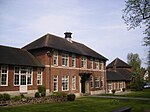Dame Elizabeth Cadbury School
Dame Elizabeth Cadbury School is a coeducational secondary school and sixth form located in the Bournville area of Birmingham, West Midlands, England. The school was named after Dame Elizabeth Cadbury. The school was established in 1955, and the author and folklorist Roy Palmer was headmaster of the school from 1972 to 1983. Later, the school gained specialist status as a Technology College and was renamed Dame Elizabeth Cadbury Technology College. Previously a foundation school administered by Birmingham City Council, in October 2016 Dame Elizabeth Cadbury Technology College converted to academy status and was renamed Dame Elizabeth Cadbury School. The school is now sponsored by the Matrix Academy Trust. The sixth form provision is offered as part of the 'Oaks Sixth Form College', a consortium of 7 secondary schools in South-West Birmingham.
Excerpt from the Wikipedia article Dame Elizabeth Cadbury School (License: CC BY-SA 3.0, Authors).Dame Elizabeth Cadbury School
Woodbrooke Road, Birmingham
Geographical coordinates (GPS) Address Nearby Places Show on map
Geographical coordinates (GPS)
| Latitude | Longitude |
|---|---|
| N 52.4281 ° | E -1.9431 ° |
Address
Riverside Bournville
Woodbrooke Road
B30 1UL Birmingham
England, United Kingdom
Open on Google Maps






